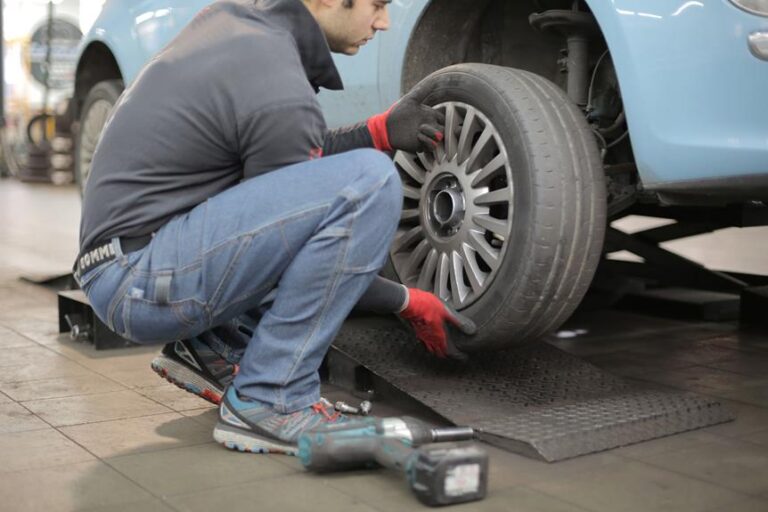Tire Aging and Expiration: Is Your Safety at Risk
Are you aware that your safety on the road could be jeopardized by the age and expiration of your tires?
In this article, we will delve into the science behind tire aging and expiration, uncovering the potential risks that may be lurking beneath the surface.
By understanding the signs of aging tires, the dangers of driving on expired ones, and the impact of temperature and climate, we aim to provide you with the knowledge necessary to ensure your tires are safe and reliable.
Key Takeaways
- Tire aging is influenced by factors such as exposure to sunlight and UV rays, temperature fluctuations, usage patterns, and maintenance.
- Tire expiration dates are important for ensuring safety on the road as aging tires become more susceptible to failure.
- Expired tires can lead to safety hazards such as reduced traction, compromised handling, and an increased risk of blowouts.
- Identifying and addressing expired tires through regular inspections and proactive replacement can reduce the risk of accidents and ensure optimal safety.
The Science Behind Tire Aging
The science behind tire aging is a complex and critical aspect that requires a thorough understanding to ensure optimal safety and performance. The tire aging process is influenced by various factors, all of which can impact the overall lifespan and reliability of the tire.
One of the key factors affecting tire aging is exposure to sunlight and ultraviolet (UV) rays. Over time, prolonged exposure to UV radiation can cause the rubber compounds in the tire to degrade, leading to cracking, dry rot, and loss of strength.
Another significant factor is temperature fluctuations. Extreme heat can accelerate the aging process by causing the tire to lose its elasticity and become more prone to blowouts, while freezing temperatures can cause the rubber to harden and lose its grip on the road.
Furthermore, tire aging is influenced by the tire's usage patterns and maintenance. Factors such as underinflation, overloading, and improper storage can all contribute to accelerated aging. It is essential to regularly check tire pressure, rotate tires, and ensure proper storage conditions to minimize the effects of aging.
Understanding the science behind tire aging is crucial for every driver. By being aware of the factors that affect tire aging, individuals can take proactive measures to extend their tire's lifespan and ensure optimal safety on the road.
Understanding Tire Expiration Dates
Understanding tire expiration dates is crucial for ensuring your safety on the road. As tires age, they become more susceptible to failure, increasing the risk of accidents.
Safety Implications of Expiration
Analyzing the safety implications of tire expiration dates reveals potential risks to vehicle owners. While many people are aware of the importance of regular tire maintenance and replacing tires when they are worn out, the expiration date of a tire is often overlooked. The reality is that tires, just like any other product, have a lifespan.
Over time, the structural integrity of the tire can deteriorate, leading to safety hazards on the road. Tire expiration risks include reduced traction, increased risk of blowouts, and compromised handling and stability. As tires age, the rubber compound can harden, making it less effective in gripping the road. This can result in longer stopping distances and decreased control, especially in wet or icy conditions. Additionally, older tires are more prone to blowouts, which can be extremely dangerous, especially at high speeds.
To ensure your safety on the road, it is essential to check your tire's expiration date and replace them accordingly. This simple act can help prevent accidents and ensure that you are driving with tires that are in optimal condition. Remember, your freedom on the road relies on your commitment to safety.
Identifying Expired Tires
When assessing the safety of tires, it is crucial to consider the process of identifying expired tires through a thorough examination of the tire's expiration date. Tire aging is a significant concern as it can lead to potential hazards on the road.
As tires age, their rubber compounds deteriorate, reducing their ability to provide traction and handle various road conditions. This degradation can result in decreased performance, increased risk of blowouts, and compromised handling.
To identify warning signs of expired tires, it is essential to check the tire's expiration date, usually indicated by a four-digit code on the sidewall. This code represents the week and year of manufacture.
Tires older than six years are generally considered expired and should be replaced, regardless of their tread depth or overall condition. By being vigilant and proactive in identifying and replacing expired tires, drivers can ensure their safety and reduce the risk of accidents on the road.
Signs of Aging Tires: What to Look For
The deteriorating condition of tires can be identified by observing visible signs such as cracks, bulges, and tread wear, indicating the potential safety risks associated with aging tires. As tires age, they become more susceptible to failure, increasing the likelihood of accidents and compromising the overall safety of the vehicle.
To ensure your safety on the road, it is important to be aware of the signs of tire aging and take necessary precautions. Here are four key signs to look out for:
- Cracks: Check for visible cracks on the sidewall or tread of the tire. These cracks can weaken the structural integrity of the tire, making it more prone to blowouts.
- Bulges: Bulges or bubbles on the tire indicate internal damage, often caused by impact or aging. These weak spots can lead to sudden tire failure, especially at high speeds.
- Tread wear: Examine the depth of the tire tread. If it is worn down to the wear bars or if the tread pattern is significantly reduced, it's time to replace the tire. Inadequate tread depth reduces traction and increases the risk of hydroplaning.
- Age: Tires have a lifespan of approximately six years, regardless of the amount of use. Check the manufacturing date on the tire to determine its age. Aging tires are more likely to deteriorate and fail, even if they appear to be in good condition.
To prevent tire aging, it is essential to maintain proper tire pressure and regularly inspect the tires for signs of wear and damage. By being proactive and addressing these issues promptly, you can ensure your safety on the road and enjoy the freedom of worry-free driving.
The Dangers of Driving on Expired Tires
Undoubtedly, driving on expired tires poses a significant risk to both the driver and other road users, as the compromised structural integrity and reduced traction increase the likelihood of accidents. The dangers of driving on worn-out tires cannot be understated, and neglecting tire maintenance can have serious consequences.
When tires reach the end of their usable life, the rubber compound begins to deteriorate, leading to reduced grip on the road. This can result in longer stopping distances and decreased control during maneuvers, particularly in wet or icy conditions. Additionally, worn-out tires are more prone to blowouts, which can lead to sudden loss of control and potentially catastrophic accidents.
Neglecting tire maintenance, such as failing to regularly check tire pressure or ignoring signs of wear and tear, can also contribute to tire failure. Over or underinflated tires can cause uneven wear, reducing their effectiveness and increasing the risk of blowouts. Similarly, ignoring signs of wear, such as cracks, bulges, or balding tread, can lead to tire failure and compromise safety on the road.
Maintaining proper tire condition is essential for safe driving. Regularly inspecting tires for signs of aging, keeping them properly inflated, and replacing them when they reach their expiration date are crucial steps to ensure optimal performance and reduce the risk of accidents.
Tire Aging and Its Impact on Traction and Handling
As tires age, their rubber compounds degrade, leading to a loss of traction and handling capabilities. This can significantly impact the overall safety of a vehicle, especially in wet or slippery conditions.
It is crucial for drivers to be aware of the age and condition of their tires, regularly checking for signs of aging and replacing them when necessary to ensure optimal traction and handling on the road.
Safety Risks of Aging Tires
Effective management of tire aging requires ongoing monitoring and assessment to mitigate potential safety risks. As tires age, they undergo physical and chemical changes that can compromise their performance and safety. To ensure your safety on the road, here are some important safety precautions and prevention methods to consider:
- Regular inspections: Check your tires regularly for signs of aging, such as cracks, bulges, or uneven wear. This will help identify potential issues before they become safety hazards.
- Proper storage: Store tires in a cool, dry place away from direct sunlight and extreme temperatures. This can help slow down the aging process and prolong the lifespan of your tires.
- Regular rotation: Rotate your tires regularly to promote even wear and extend their lifespan. This will help prevent premature aging and ensure optimal performance.
- Timely replacement: Be proactive in replacing aged tires. Even if they appear to have sufficient tread, old tires can still pose significant safety risks. Follow manufacturer guidelines for tire replacement based on age and wear.
Traction and Handling Effects
Our understanding of the traction and handling effects of tire aging is crucial in ensuring optimal safety on the road.
As tires age, their performance gradually deteriorates, impacting both fuel efficiency and wet weather performance.
Tire aging can lead to decreased traction, reduced handling capabilities, and increased braking distances. This can be particularly dangerous in wet conditions, where the risk of hydroplaning and loss of control is significantly higher.
Additionally, aged tires are less efficient in terms of fuel consumption, as their rolling resistance increases over time.
It is therefore essential to regularly inspect and replace tires that have reached their expiration date or show signs of aging, such as cracking or uneven wear.
How Temperature and Climate Affect Tire Aging
Temperature fluctuations and environmental conditions play a crucial role in the aging process of tires, impacting their performance and safety. Understanding how tire aging is affected by climate change and temperature variations is essential for maintaining optimal tire functionality and ensuring road safety. Here are four key points to consider:
- Oxidation: High temperatures accelerate the oxidation process in tires, leading to the breakdown of rubber compounds. This degradation reduces tire flexibility and increases the risk of blowouts.
- UV Exposure: Prolonged exposure to sunlight can cause tire sidewalls to crack and deteriorate. UV rays weaken the rubber, compromising the tire's structural integrity and overall performance.
- Moisture and Humidity: Wet or humid conditions can accelerate the aging process by promoting the growth of mold and mildew. This leads to weakened tire sidewalls and reduced traction, increasing the risk of hydroplaning.
- Effects on Fuel Efficiency: As tires age, their rolling resistance increases, negatively impacting fuel efficiency. This means that older tires require more energy to maintain the same speed, resulting in decreased mileage and increased fuel consumption.
Given these factors, regular tire inspections, proper storage, and timely replacement are essential for maintaining tire safety and prolonging their lifespan. By staying vigilant and taking necessary precautions, drivers can ensure their safety on the road and mitigate the effects of tire aging and climate change on fuel efficiency.
Proper Tire Maintenance to Extend Lifespan
Regular tire maintenance, such as proper inflation and regular rotation, is crucial to extend the lifespan of your tires and ensure optimal performance on the road. Neglecting these maintenance tasks can lead to premature tire aging and potential safety hazards. To help you keep your tires in top condition, here are some tire maintenance tips and aging prevention measures:
| Tire Maintenance Tips | Tire Aging Prevention |
|---|---|
| Regularly check tire pressure and inflate as needed | Park your vehicle in a cool, shaded area |
| Rotate your tires every 5,000 to 7,000 miles | Avoid overloading your vehicle |
| Inspect tires for signs of wear and damage | Avoid prolonged exposure to sunlight and harsh weather conditions |
| Ensure proper wheel alignment and balance | Use tire covers when the vehicle is not in use |
| Follow the manufacturer's recommended tire replacement guidelines | Avoid using expired or old tires |
Tire Aging and the Importance of Regular Inspections
An understanding of tire aging and the importance of regular inspections is crucial for maintaining optimal safety on the road. As tires age, their performance and ability to grip the road deteriorate, increasing the risk of accidents. Regular maintenance and inspections can help identify potential issues before they become a safety hazard.
Here are four reasons why regular inspections are essential for tire safety:
- Tire lifespan: Regular inspections can help determine the remaining lifespan of your tires. Over time, the rubber compounds in tires degrade, leading to reduced performance and increased risk of blowouts. By monitoring the tread depth and overall condition of the tires, you can ensure they are replaced before reaching a critical point.
- Tire pressure: Proper tire inflation is crucial for optimal performance and safety. Regular inspections allow you to check the tire pressure and adjust it as needed. Underinflated or overinflated tires can lead to reduced fuel efficiency, uneven tire wear, and decreased traction.
- Tire wear: Inspections help identify uneven tire wear, which can indicate alignment or suspension issues. Uneven wear patterns can compromise the tire's ability to grip the road and increase the risk of hydroplaning or skidding.
- Damage detection: Regular inspections enable you to identify any visible damage, such as cuts, bulges, or punctures. Addressing these issues promptly can prevent tire failure and potential accidents.
Choosing the Right Tires to Minimize Aging and Expiration Risks
To minimize the risks of aging and expiration, it is important to carefully select and choose the right tires for your vehicle. Proper tire maintenance is crucial for ensuring your safety on the road and extending the lifespan of your tires. With the constant wear and tear that tires endure, it is essential to understand the factors that contribute to aging and expiration.
When choosing tires, it is important to consider the specific needs of your vehicle. Factors such as the type of terrain you frequently drive on, the weather conditions in your area, and your driving habits should all be taken into account. Additionally, selecting tires from reputable brands known for their durability and performance can help minimize the risk of premature aging.
Once you have chosen the right tires, regular maintenance is key to ensuring their longevity. This includes regular inspections for any signs of wear or damage, proper inflation, and regular rotation to ensure even wear. It is also important to be mindful of the manufacturer's recommended lifespan for your tires, as using them beyond this point can increase the risk of failure.
Frequently Asked Questions
Can I Still Use My Tires if They Have Expired?
Expired tires can have a significant impact on vehicle handling and tire puncture resistance. It is not recommended to use tires past their expiration date, as it can jeopardize your safety on the road.
Can Tire Aging and Expiration Affect Fuel Efficiency?
Tire aging and expiration can indeed affect fuel efficiency. As tires age, their rubber compounds harden, leading to increased rolling resistance and decreased fuel economy. It is important to prioritize tire durability and performance for optimal fuel efficiency.
How Can I Check the Manufacturing Date of My Tires?
Manufacturing date verification is crucial for determining the age of your tires. By checking the DOT code on the sidewall, you can identify the week and year of manufacture, ensuring you are aware of the tire's age and potential safety risks.
Are There Any Specific Tire Brands That Are Less Prone to Aging and Expiration?
While there are no specific tire brands that are immune to aging and expiration, tire longevity and maintenance play crucial roles in ensuring safety. Regular inspections, proper inflation, and avoiding excessive heat and UV exposure can help extend tire lifespan.
Can Tire Aging and Expiration Impact the Braking Performance of My Vehicle?
Tire aging and expiration can significantly impact the braking performance of a vehicle. As tires age, their lifespan and durability decrease, increasing the risk of blowouts. It is crucial to regularly inspect and replace tires to ensure optimal safety on the road.
Conclusion
In conclusion, tire aging and expiration pose serious risks to safety on the road. Understanding the science behind tire aging and expiration dates is crucial in order to identify signs of aging and prevent accidents.
Additionally, temperature and climate play a significant role in tire aging, making regular inspections and proper maintenance essential. Choosing the right tires can also minimize the risks associated with aging and expiration.
It is important to note that according to a study conducted by the National Highway Traffic Safety Administration, nearly 1 in 11 vehicles on the road have at least one tire that is significantly underinflated, increasing the chances of tire failure and accidents.







